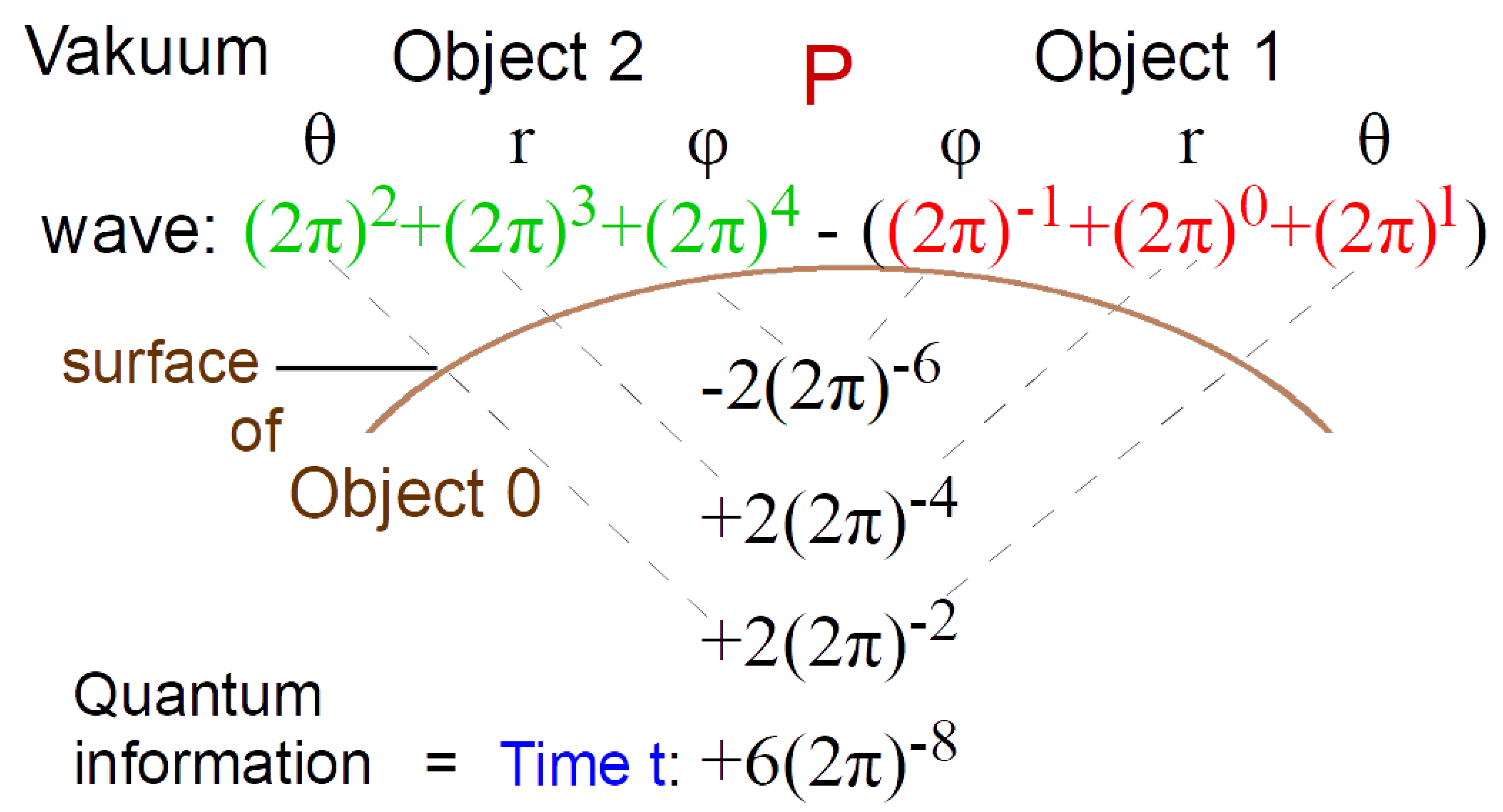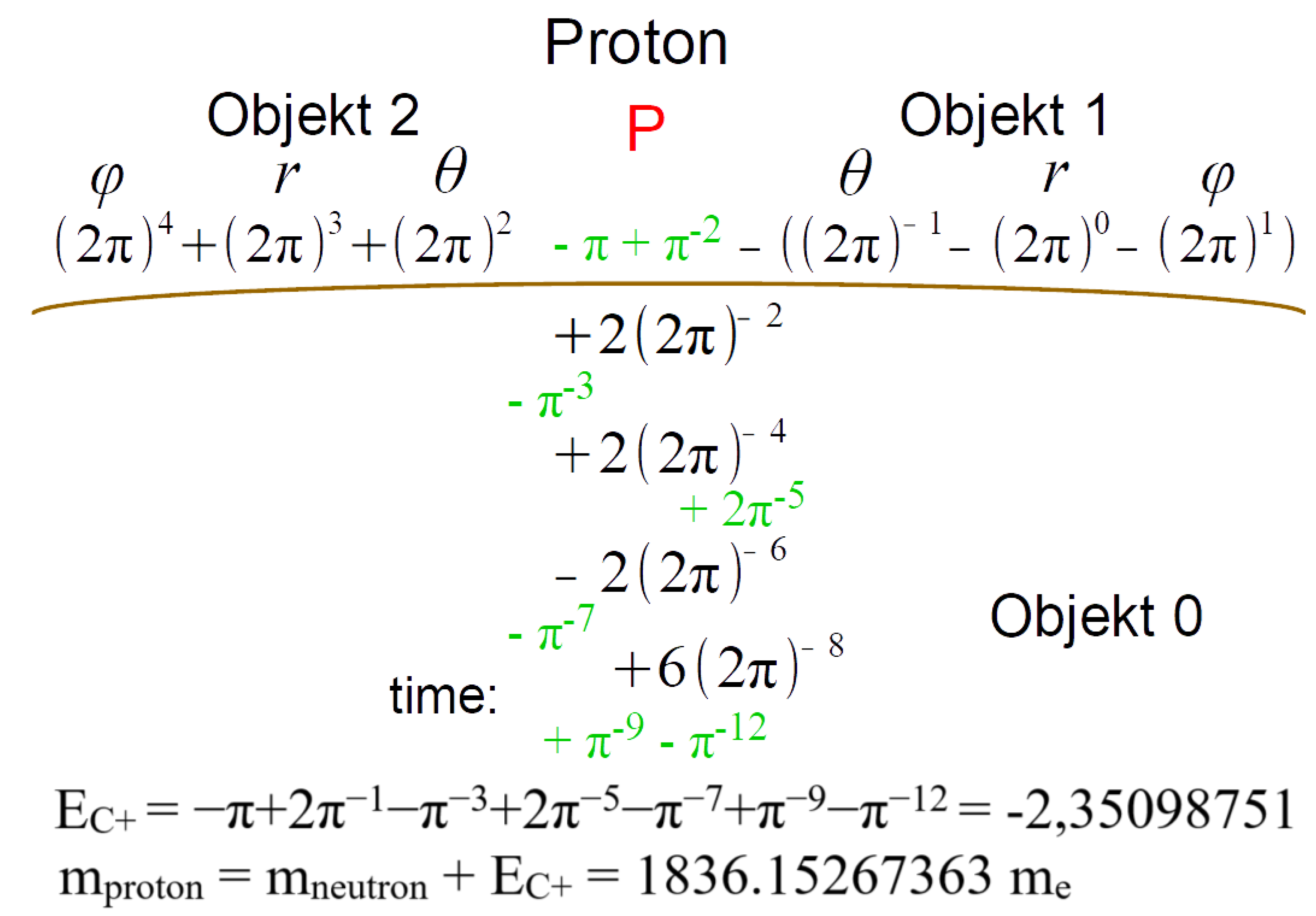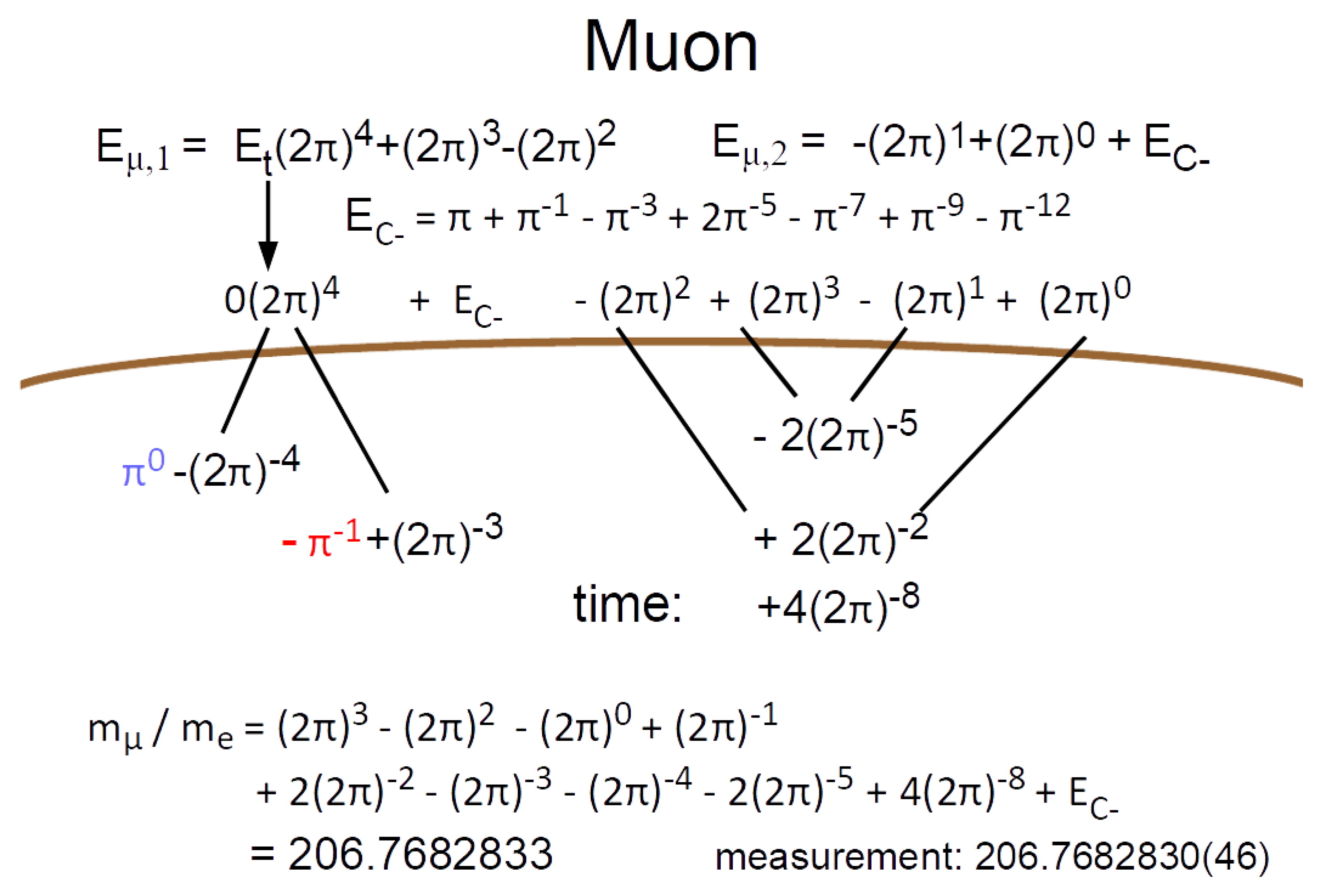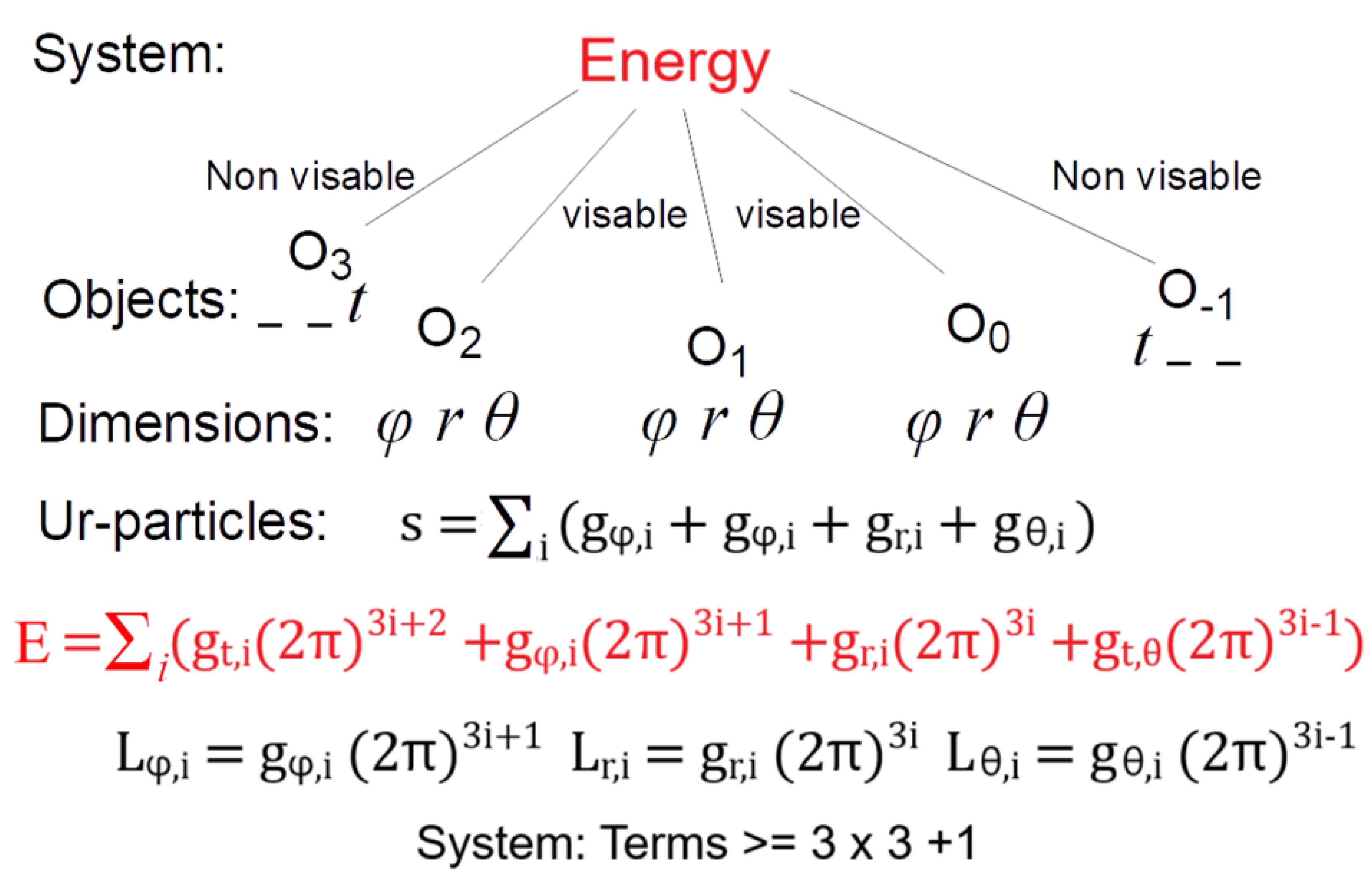2.1. Ur-Alternatives: ur-Particles - Dimensions - Objects - System
A system consists of at least 3 visible or invisible objects
, each with 3 spatial coordinates. Standardization is performed on the Earth’s surface with a meter and a second (object
.
The number of ur-particles with dimension d
refers to the local spatial coordinates and time:
The number
s of ur-particles starts in the center of the system.
At the end of the object is complete and corresponds to its surface and rest mass.
The distributions of , and lead to different states (elementary particles, atoms and molecules) with different densities and orbits (planets, lunar resonances and eccentric orbits). For example, in the interior of the sun, due to nuclear fusion, neutrino production is (see 2.7. Muon). For objects at rest or within elementary particles the time is allowed.
Coincidences can be measured after revolutions of
. In the following, the coordinate system for
is referred to as epicyclic coordinates. The dimensions
,
,
and
are used in the exponent.
A differentiation between angular momentum L, energy E and action S is not necessary. The meaning of E is indicated by the indices of the object and the dimensions. The difference between the moving and stationary location coordinates of objects is insignificant for the energy ratios
. The radius itself is curved, which allows a simple formulation of general relativity, i.e.
is no different from the circular arcs
and
. In a system, the spatial coordinates of objects move in a spiral in the direction of time, analogous to geodesic lines.
Neutral objects (Neutron, Photon or Earth) consist of complete revolutions of
A measuring device is a neutral, solid object with a surface as a sensor to vacuum. A vacuum can consist of invisible objects (e.g. photons/gluons) or, for comparison, two immediately adjacent objects and .
Since the angular momentum is conserved for each of the dimensions, there can be no algebraic function between the dimensions. Thus,
, 1 and
are the epicyclic coordinates of the ur-particles and correspond to the neutrinos
,
and
respectively. The electron is the first object with 3 spatial coordinates:
The term
is negative and causes attraction in the gravitational field to a neighboring object. In quantum theory,
corresponds to spin 1/2 and explains the interaction between objects. According to the theory, an electron consists of 2 ur-particles, or neutrinos, which move orthograde with
c, with the combined energy
. Orthograde to this is
, which is the relative speed in the electric field and leads to the Lorenz gauge. Further decimal places are summarized with
and only result together with another object or the measurement (see 2.4. Muon). A free electron moves in spacetime 4D with time
.
A basic principle of the theory is that the number of ur-particles is countable. The energies are always transcendental powers of . are orthogonal and unique for the dimensions d. If the rest mass of the electron is normalized to 1, the spin is always a rational number of . is a frequency, e.g. for the electron . All calculations for neutrons, protons or atoms involve at least . The question of dimensions in space is secondary in this theory. The rest mass of a neutron can be formulated in 10 dimensions (see 2.5 Neutron) or, in our imagination in 4 dimensions ( , Poincare group ) or one dimension in our brain network. The increase of dimensions i by for the binding energy is consistent with the no-go theorem "all possible symmetries of the S matrix" [6].
2.3. Photon - Composed of Neutrinos
A photon are world lines of superimposed and entangled neutrinos (
,
and also corresponds to superimposed electrons
and
with a minimum energy
. A photon can be calculated only as a system of emission (object
) and absorption
. For the spatial part of
,
can be used together with the prefactors
and
,
and
. For simplification, a prefactor
is used in the photon.
The term
determines the frequency. The dimensionless formula is adjusted to
.
The radial component
is the length of the wave train and, depending on the polarization
, leads to two opposite components
and
, which can be summarized as
. For a wave,
and
are reciprocal.
. For a complete wave train, the following applies:
the mean of the energy component
of the photon is independent of the length of the wave train
.
The
component has a negative energy and leads to an attraction in the gravitational field relative to a measuring device, with the smallest possible prefactor for a neutral object
:
2.3.1. Interpretation of the Compton Effect via Polynomials
For the Compton effect between photon, electron, and measuring device (
), the common momentum is zero. The increase
does not depend on the original photon energy, but on the absorption of the energy
. With the Compton wavelength
there is a connection between
in quantum theory and the macro world with
. The approach of the polynomials for the Compton effect between the electron, photon and recoil
is as follows:
For a resting electron, with . For the dimension r, the absorption is caused by the excitations of the term . The minimum energy from this term is and results in the total energy term of .
Estimate for
with the 3 required terms for a photon:
This value is accurate to 4 decimal places. h cannot be replaced by this. The calculation is again dependent on the Planetary System. (see Chapter 3 Planetary System). Further research is needed for this purpose.
2.3.2. Fine structure constant
Using the simple concept of the Bohr atomic model,
is the speed of the electron in orbit. In the ground state,
. For the binding of the electron,
. Approximation for
:
The calculation is accurate to ‰. It remains to be seen whether a further series expansion will produce a more accurate result or whether it is limited by the gravitational constant.
2.3.3. Neutrino Oscillation
The rotations of the neutrino world lines correspond to the energies.
Accordingly, in quantum theory, neutrino mass eigenstates
are plane waves [9].
Neutrino oscillations are caused by the shift of the phase
compared with the measuring device with base
and, in other words, a consequence of the gravitational field.
The measurements of the neutrion energies are only possible in a system of emission/decay and absorption in the detector:
. The calculation of the muon mass from
and
via the algorithm (see 2.7 Muon) leads to
with mass
, where normalization is related to the electron mass
. For the spatial dimensions
r, the following would be assumed for
:
An important decay of the Tau into leptons is
. Other decay channels lead to hadrons, such as pions and kaons. The largest term of the tau mass is
(see 2.8 Tau). The term
is crucial for neutrino
. For a single
with
, the relationship to the electron
is analogous to
:
When muons and Taus decay, an antineutrino
is created.
is the
and causes gravity. The rest mass of
is theoretically negative, but contradicts the principle that the longitudinal velocity
.
2.4. Neutral Objects
The surface of every object rotates with a frequency
. Only a system of at least 3 objects provides conclusions about frequencies
and radii
.
The frequency
and the phase are unique relative to object
. In a measuring device
the common time
is determined and can also be given as a measured value in spatial coordinates. The curved surface of
can be considered a sensor (see
Figure 2). For each of the three spatial dimensions there are three focal points of
and
below the curved surface of
:
The energies of the spatial coordinates are summarized as
:
leads to the common time
and gives the total energy in the measuring device.
This gives an algorithm to calculate
step by step from high to low energies, with two loops for
and
. In detail, the dimensions
for objects
and
are marked with the parameters
{4,3,2} and
{1,0,-1}. According to the law of gravitation
, F decreases with the second power of r. Similarly,
decreases for neutral objects with
.
The starting values are those of objects 1 and 2 and are calculated for object 0 with the reciprocal of the corresponding dimension, the exponent . This geometric mean also contains the factor or 2. If this factor was 1, there would be straight lines in the cosmos. For a curved space, the factor is minimal.
The equation
is the core of the algorithm. The structure corresponds to a Christoffel symbol from GR:
The essential point is to replace the partial derivatives with respect to the dimensions by the quanta
and apply this to matter. The equation
includes negative energies of
, i.e. antimatter. This also allows other elementary particles such as muons, Taus and pions to be calculated. If
, a pair of neutrino and antineutrino can be created (see 2.7. Muon). Another interpretation of a system by
is the reflection / inversion of the external worlds of
and
into the internal world
of the observer at the unit circle
(see 2.9. Quarks u and d).
The algorithm is similar to a lattice gauge calculation and is based on the specifications of two objects that are compared in the measuring device. This comparison is carried out step by step with 2 loops to speak into the depth of the measuring device until the result is processed at the common point in time (see
Figure 2 and
Figure 3 for neutrons and protons). In lattice gauge theory, this common point in time corresponds to the minimum distance with a cut-off in momentum space, i.e., the point at which no more divergence occurs. In lattice gauge theory, the effect S is also summed via loops (Wilson loops). The normalization for the lattice gauge theory is based on the coupling constants, whereas the algorithm is based on powers of
.
2.7. Muon
First estimate for the rest mass:
This follows from a minimum energy with a frequency
and a radial component
. It is assumed that the negative and positive charges are related:
The neutral part can be separated from
:
The calculation of the energy
in
is carried out step by step according to algorithm (2.22). Depending on the signs in
and
, multiplication is carried out by
for matter or by 2 for antimatter:
To fully calculate , the placeholder must be included. According to the Heisenberg uncertainty principle, the decay of muon is possible with an energy of :
Production from
Production of
In summary, the rest mass of the muon is:
Theory: 206.7682833 Measurement: 206.7682830(46) [10]
The decay results from the division of the energies
into 3 new objects with kinetic energy
.
Figure 4 corresponds to a Feynman diagram. The probabilities for the energies and momenta are given by the QT.
Figure 4.
as a polynomial with the decays in and .
Figure 4.
as a polynomial with the decays in and .
2.9. Quarks u and d
Table 1 lists the quarks [11] with rest masses from the mean
and standard deviation in MeV [10]. The first estimate of
in
is the highest power d
with
(
Table 1). The standard deviations in powers of
are estimated as
:
Table 1.
quarks with rest masses from the mean and standard deviation in MeV.
Table 1.
quarks with rest masses from the mean and standard deviation in MeV.
| Quark |
in MeV |
|
|
estimate in
|
|
|
| u |
2.16 |
-0.26 |
0.49 |
|
1.0091 |
|
| d |
4.67 |
-0.17 |
0.48 |
|
0.9696 |
|
| s |
93.4 |
-3.4 |
8.6 |
|
1.1052 |
|
| c |
1270 |
-20 |
20 |
|
1.0630 |
|
| b |
4180 |
-20 |
30 |
|
1.1137 |
|
| t |
172760 |
-300 |
300 |
|
0.9947 |
|
| Higgs |
125110 |
-110 |
110 |
boson |
1.1660 |
|
| Atom |
|
|
|
|
The charges of quarks u, s and b are -1/3, and those of quarks d, c and t are +2/3 and can be measured only relative to the environment. Only the energies of the quarks whose measurement ranges are within one standard deviation are relevant.
In first order, the energy difference between neutrons (udd) and protons (uud) results from the three ur-particles . By swapping between , and , the third charges and of the quarks result. Quarks u and d have frequencies and .
Assuming that the prefactors
-1, -1/2, 0, 1/2, 1 and
, the energies are
. For various combinations of
and
, the mean
and standard deviation of
and
follow (
Table 2):
Table 2.
Quarks and d. Comparison between theory and the measurement.
Table 2.
Quarks and d. Comparison between theory and the measurement.
| u |
|
|
|
= |
Theory
|
Measurement |
|
|
+ 0 |
|
4.19 |
2.14 |
2.16 MeV |
|
|
+ 1 |
|
5.19 |
2.66 |
2.65 MeV |
|
|
- 1/2 |
|
3.69 |
1.89 |
1.90 MeV |
|
|
|
|
|
|
|
| d |
|
|
|
= |
Theory
|
Measurement |
|
|
+ 0 |
|
9.106 |
4.65 |
4.67 MeV |
|
|
+ 1 |
|
10.11 |
5.16 |
5.15 MeV |
|
|
- 1 |
|
8.74 |
4.47 |
4.50 MeV |
The energy results from the 3-dimensional components of the particles on the orbit. From the maximum range of energies
, a common constant
can be derived, which corresponds to an area. The area
around the center
results in the area
and rotates
with the rotation time in 4-dimensional space, i.e. taking gravity into account.
The ranges of and with limits and depend not only on and in the interior, but also on the environment and thus on the measurements. The limits change with the distance a of the quarks with the required time . The closer the quarks are, the more common angular momentum is determined by the prefactors and with quanta and the minimum energy. The inversion at the unit circle and reflects the objects and in the measuring device . The number of ur-particles remains constant. The theory requires c as the only parameter and is standardized with units of meters (m). The circumference is the smallest possible string for a complete rotation from the multitude of strings according to string theory.
The charge, iso, spin, mean and standard deviation result from the symmetry in the unit circle with multiples z of 30° with
2.10. Pion
The approach for the rest mass of the pions requires bosons/gluons in with for the frequency and for the majority of the rest mass :
Pions: and :
results from the addition of the energies of the quarks:
Minimum of the energy of
and
(see table for u and d):
First estimate from :
Measurement: 139.57039(18)
For a more precise calculation of the decimal places, the powers are separated from :
With algorithm (2.15) and the symmetry point , it follows that:
It can be assumed that the term is crucial for the symmetry of the charges. The entire term for charged pions is currently speculative:
= 139.5705 MeV measurement: 139.57039(18) [10]
Pion :
Extremum of the energy of and (see table for u and d):
First estimate from : 134.94336 MeV Measurement: 134.9768(5)
The decay of the neutral pion occurs with stronger and faster electromagnetic interaction:
(probability of ) or
(probability of ).
is the only term in that holds the pion together before decay. It is the spin for the 2 entangled photons after decay. is thus a neutral polynomial . According to the symmetry at r = 2, follows with an extension of the algorithm (2.15):
= 134.9761 MeV Measurement : 134.9768(5) [10]
Further research into the algorithm and calculations for quarks s, c, b and t and the Higgs-boson are needed.








